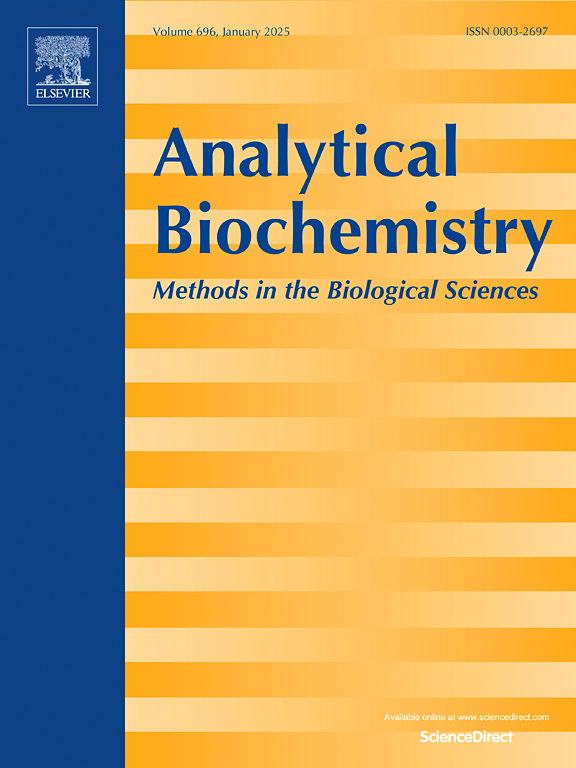结构酸甘油三酯筛选区域选择性脂肪酶的微孔板法:从念珠菌异构体中发现具有sn-2区域选择性的Lip4脂肪酶。
IF 2.6
4区 生物学
Q2 BIOCHEMICAL RESEARCH METHODS
引用次数: 0
摘要
在本研究中,我们提出了一种连续测定法,它提供了一种高通量、高效率的方法来筛选三酰甘油(TAGs)上 Sn-1,3 和 sn-2 位上的脂肪酶的区域选择性。该测定法可测量含有油酸(O)和布酸(P)的 TAG 衍生物的主位和次位的特定水解率。该方法基于 sn-POP(sn-1,3 区域特异性脂肪酶)和 sn-OPO(sn-2 区域特异性脂肪酶)水解释放出的布匿酸的吸光度比值。我们使用已知和未知区域选择性的纯脂肪酶对该方法进行了验证。出乎意料的是,我们发现重组粗毛念珠菌脂肪酶 4(rCRLip4)表现出显著的 sn-2 区域选择性,表明其区域选择性高于重组南极念珠菌脂肪酶 A(rCALA)。为阐明 CRLip4 与非区域选择性异构体 CRLip1 之间的主要结构差异,进行了硅学分析和分子对接研究。这种针对 TAG 的连续区域选择性脂肪酶测定方法用途广泛,可用于筛选 sn-1、3、sn-2 或非区域选择性脂肪酶。它在生物催化生产结构脂和其他对区域选择性至关重要的工业过程中具有重要的潜在应用价值。本文章由计算机程序翻译,如有差异,请以英文原文为准。

Microplate spectrophotometric method for regioselective lipase screening using structured triglycerides with punicic acid as probe
In this study, we propose a continuous assay that provides a high-throughput, efficient method for screening the regioselectivity of lipases at the sn-1,3 and sn-2 positions on triacylglycerols (TAGs). This assay measures the specific hydrolysis rates at the primary and secondary positions of TAGs derivates containing oleic (O) and punicic (P) acids. The method is based on the absorbance ratio of released punicic acid from the hydrolysis of sn-POP (sn-1,3 regiospecific lipases) and sn-OPO (sn-2 regiospecific lipases). The method was validated using pure lipases with known and unknown regioselectivity. Unexpectedly, we found that recombinant Lipase 4 from Candida rugosa (rCRLip4) exhibited significant sn-2 regioselectivity, indicating greater regioselectivity than recombinant lipase A from Candida antarctica (rCALA). In silico analysis and molecular docking studies were conducted to elucidate the main structural differences between CRLip4 and the non-regioselective isoform CRLip1. This continuous regioselective lipase assay on TAGs is versatile and can be used to screen for sn-1,3, sn-2 or non-regioselective lipases. It holds significant potential applications in the biocatalytic production of structured lipids and other industrial processes where regioselectivity is crucial.
求助全文
通过发布文献求助,成功后即可免费获取论文全文。
去求助
来源期刊

Analytical biochemistry
生物-分析化学
CiteScore
5.70
自引率
0.00%
发文量
283
审稿时长
44 days
期刊介绍:
The journal''s title Analytical Biochemistry: Methods in the Biological Sciences declares its broad scope: methods for the basic biological sciences that include biochemistry, molecular genetics, cell biology, proteomics, immunology, bioinformatics and wherever the frontiers of research take the field.
The emphasis is on methods from the strictly analytical to the more preparative that would include novel approaches to protein purification as well as improvements in cell and organ culture. The actual techniques are equally inclusive ranging from aptamers to zymology.
The journal has been particularly active in:
-Analytical techniques for biological molecules-
Aptamer selection and utilization-
Biosensors-
Chromatography-
Cloning, sequencing and mutagenesis-
Electrochemical methods-
Electrophoresis-
Enzyme characterization methods-
Immunological approaches-
Mass spectrometry of proteins and nucleic acids-
Metabolomics-
Nano level techniques-
Optical spectroscopy in all its forms.
The journal is reluctant to include most drug and strictly clinical studies as there are more suitable publication platforms for these types of papers.
 求助内容:
求助内容: 应助结果提醒方式:
应助结果提醒方式:


